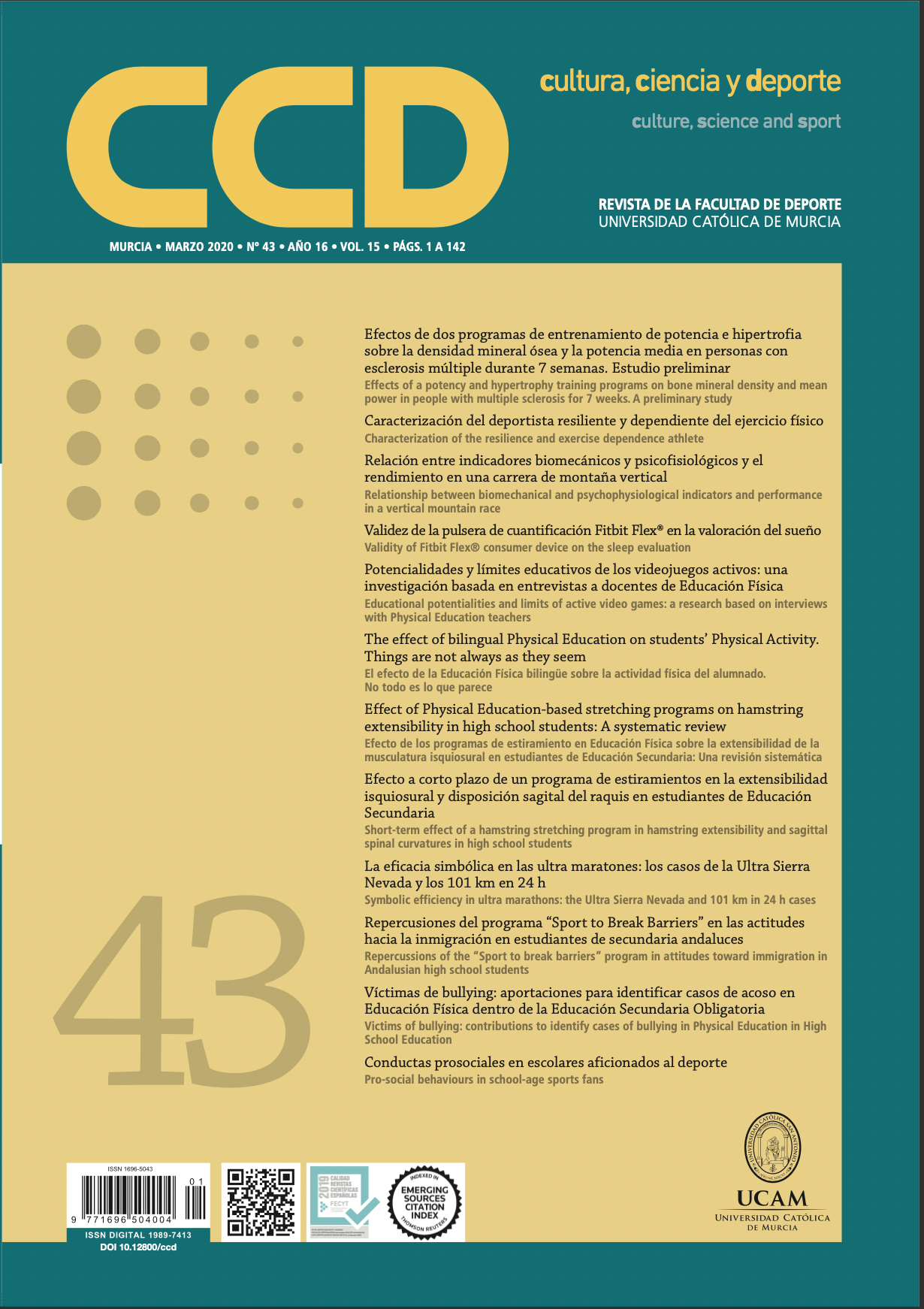La eficacia simbólica en las ultra maratones: los casos de la Ultra Sierra Nevada y los 101 km en 24 h.(Symbolic efficiency in ultra marathons: the Ultra Sierra Nevada and 101 km in 24 h cases).
DOI:
https://doi.org/10.12800/ccd.v15i43.1402Keywords:
Ultra maratón, símbolos, identidad, ideología, sociedad.Abstract
En la actualidad, la elevada exigencia física y psíquica que implica preparar ultra maratones no ha impedido que este tipo de pruebas se haya popularizado y convertido en una importante manera de demostrar autenticidad en la obra personal. A través del trabajo etnográfico, la revisión histórica y la experiencia práctica en dos carreras de estas características, como son la Ultra Sierra Nevada de Granada y los 101 km. en 24 h. de Ronda, mostramos pruebas significativas para entender cómo y en qué medida, a través de la carga simbólica que poseen, ambas contribuyen en la formación del sí mismo de quienes participan en ellas y de quienes las organizan. La superación de retos personales, la popularización de la heroicidad, la formación de una identidad colectiva, la consideración de lo sagrado y la reivindicación y proyección de una ideología con valores castrenses son interpretados como los principales resultados obtenidos.
===
Nowadays the high physical and psychological demands of ultra marathons have not prevented this type of races from becoming popular and an important way to demonstrate authenticity in personal work. Through the ethnographic work, the historical review and practical experience in two competitions, such as the Ultra Sierra Nevada of Granada and 101 km. In 24 h. of Ronda, we show significant evidence to understand how and to what extent, through the symbolic burden they have, both contribute to the formation of one self for those who organice and participate in them. The overcoming of personal challenges, the popularization of heroism, the formation of a collective identity, the consideration of the sacred and the claim or projection of an ideology with military values are interpreted as the main results obtained.
References
Acuña, A. (2003). El sentido del límite y el límite del sentido. 101 kilómetros en 24 horas. En F. Medina & R. Sánchez (Eds.), Culturas en juego. Ensayos de antropología del deporte en España (pp. 275-296). Barcelona: Icaria.
Acuña, A. (2006). Etnología de la carrera de bola y ariwetararámuri. México: CIESAS. Bourdieu, P. (1991). El sentido práctico. Madrid: Taurus.
Cejka, N., Rüst, Ch. A, Lepers, R., Onywera, V., Rosemann, Th. & Knechtle, B. (2014). Participation and performance trends in 100-km ultra-marathons worldwide. Journal of Sports Sciences, 32, 354-366. doi: 10.1080/02640414.2013.825729
Clemente-Suárez, V.J. (2017). Cortical arousal and central nervous system fatigue after a mountain marathon. Cultura, Ciencia y Deporte, 12 (35), 143-148. doi: 10.12800/ccd.v12i35.886
Coast, J. R., Blevins, J. & Wilson, B. (2004). Do gender differences in running performance disappear with distance?. Canadian Journal of Applied Physiology, 29, 139-145. doi: 10.1139 / h04-010
Damm, H. (1973). Ejercicios deportivos de los pueblos primitivos. Citius, Altius, Fortius, tomo XV, fasc. 1-4.
Diem C. (1966). Historias de los deportes. Tomo I. Barcelona: Diamante. Douglas, M. (1970 [1966]). Pureza y peligro. Madrid: Siglo XXI.
Fonseca-Engelhardt, K., Knechtle, B., Rüst, Ch. A., Knechtle, P., Lepers, R. & Rosemann, Th. (2013). Participation and performance trends in ultra-endurance running races under extreme conditions - ’Spartathlon’ versus ’Badwater’. Extreme Physiology & Medicine, 2 (1), texto 15. doi: 10.1186/2046-7648-2-15
Geertz, C. (1987 [1973]). La interpretación de las culturas. México: Gedisa.
Gerosa, D., Rüst, Ch. A., Rosemann, Th. y Knechtle, B. (2014). Participation and performance trends in 161km ultra-marathons in terms of nationality –a retrospective data analysis of worldwide participation from 1998-2011. Journal of Human Sport & Exercis, 9 (2), 502-515. doi: 10.14198/jhse.2014.92.01
Harris, M. (1981 [1971]. Introducción a la antropología general. Madrid: Alianza Universal. Hocart, A. (1985 [1952]). Mito, ritual y costumbre. Ensayos heterodoxos. Madrid: Siglo XXI.
Hoffman M. (2010). Performance trends in 161-km ultramarathons. International Journal of Sports Medicine, 31, 31-37. doi: 10.1055/s0029-1239561
Hoffman, M. & Fogard, K. (2012). Demographic characteristics of 161- km ultramarathon runners. Research in Sports Medicine, 20 (1), 59-69. doi: 10.1080/15438627.2012.634707
Hoffman, M., Ong, J. & Wang, G. (2010). Historical analysis of participation in 161 km ultramarathons in North America. InBIBLIOGRAFÍA ternational Journal of the History of Sport, 27, 1877-1891. doi: 10.1080/09523367.2010.494385
Knechtle, B., Rüst, Ch. A., Rosemann, Th. y Lepers, R. (2012). Age-related changes in 100-km ultra-marathon running performance. Age, 34, 1033-1045. doi: 10.1007/s11357-011-9290-9
Knechtle, B. y Nikolaidis, P. (2015). Ultra-marathon running. Dansk Sportsmedicin, 19 (4), 6-10.
Medina, F. X., Abadía, S., Sánchez, R., Bantulà, J. & Morejón, S. (2015). El caso de la Trailwalker Intermón-Oxfam en Cataluña. International Journal of Scientific Management and Tourism, 1, 95-107.
Peter, L., Rüst, Ch. A., Knechtle, B., Rosemann, Th. & Lepers, R. (2014). Sex differences in 24-hour ultra-marathon performance - A retrospective data analysis from 1977 to 2012. Clinics (Sao Paulo), 69, 38-46. doi: 10.6061/clinics/2014(01)06
Ricoeur, P. (1996 [1990]). Sí mismo como otro. Madrid: Siglo XXI. Rocher, G. (1973). Introducción a la sociología general. Barcelona: Herder Ruiz-Juan, F., Zarauz, A. & Gabriel Flores-Allende (2016). Dependencia al entrenamiento y competición en corredores de fondo en ruta. Cultura, Ciencia y Deporte, 11 (32), 149-155. doi: 10.12800/ccd.v11i32.714
Rüst, Ch. A., Knechtle, B., Rosemann, Th. & Lepers, R. (2013). Analysis of performance and age of the fastest 100-mile ul-tra-marathoners worldwide. Clinics (Sao Paulo), 68, 605-611. doi: 10.6061/ clinics/2013(05)05 Shalins, M. (1997 [1976]). Cultura y razón práctica. Barcelona: Gedisa.
Sperber, D. (1974 [1988]). El simbolismo en general. Barcelona: Anthropos.
Turner, V. (1980 [1963]). La selva de los símbolos. Madrid: Siglo XXI. Turner, V. (1988 [1969]). El proceso ritual. Madrid: Taurus.
Van Gennep, A. (2008 [1909]) Los ritos de paso. Madrid: Alianza Editorial. Weule, K. (1974). Etnología del deporte. Citius, Altius, Fortius, tomo XVI, fasc. 1-4.
Zingg, M., Rüst, Ch. A., Lepers, R., Rosemann, Th. & Knechtle, B. (2013). Master runners dominate 24-h ultramarathons worldwide-a retrospective data analysis from 1998 to 2011. Extreme Physiology & Medicine, 2, texto 21.
Downloads
Published
How to Cite
Issue
Section
License
The authors who publish in this journal agree with the following terms:
- The authors retain the copyright and guarantee the journal the right to be the first publication of the work as well as licensed under a Creative Commons Attribution License that allows others to share the work with recognition of the authorship of the work and the initial publication in this journal.















